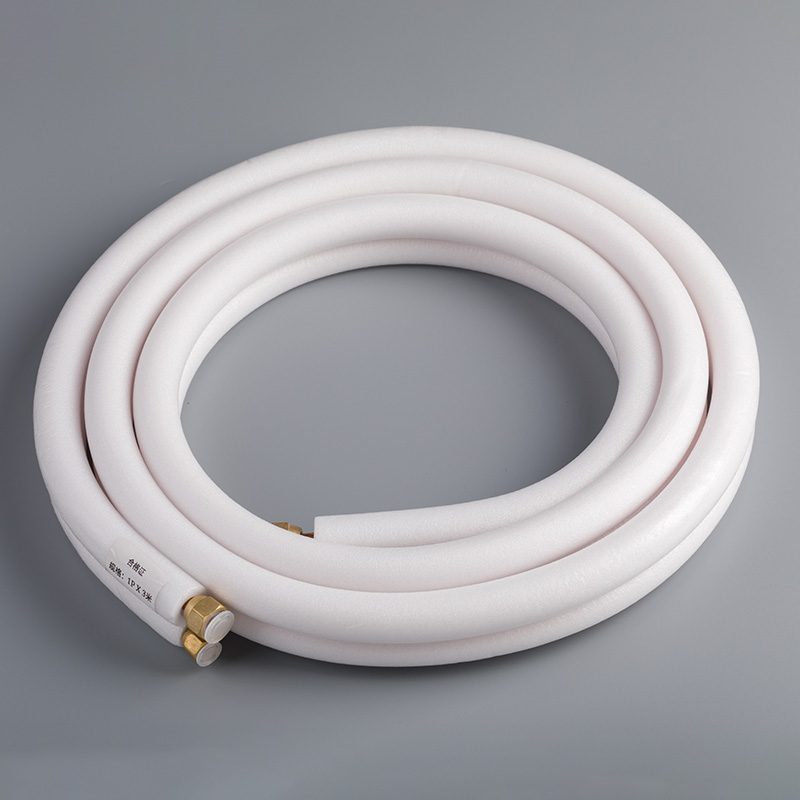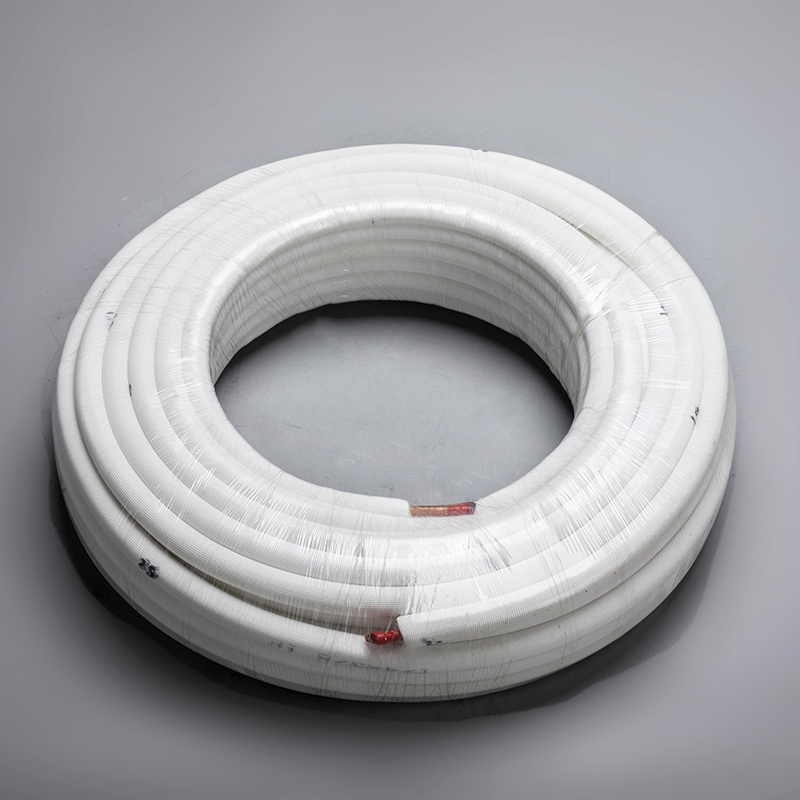What are the standard copper line set sizes for air conditioners

Copper line sets play a vital role in air conditioning systems by transporting refrigerant between the indoor and outdoor units. The most common air conditioner copper line set sizes include 1/4 inch, 3/8 inch, 1/2 inch, 5/8 inch, 3/4 inch, and 7/8 inch. Each size has specific dimensions and wall thicknesses to ensure durability and performance:
1/4 inch: Outer Diameter (O.D.): 0.375, Inner Diameter (I.D.): 0.305, Wall Thickness: 0.035
3/8 inch: O.D.: 0.500, I.D.: 0.402, Wall Thickness: 0.049
1/2 inch: O.D.: 0.625, I.D.: 0.527, Wall Thickness: 0.049
Proper sizing ensures efficient refrigerant flow, prevents system contamination, and extends the lifespan of your air conditioner. Studies show that well-maintained copper lines can last up to 20 years, making them a reliable choice for HVAC systems.
Key Takeaways
Copper pipes are important for moving coolant between AC units. Picking the right size helps cooling and makes the system last longer.
Common pipe sizes are 1/4 inch, 3/8 inch, 1/2 inch, 5/8 inch, 3/4 inch, and 7/8 inch. Use the size that matches your AC's needs.
Follow the maker's rules for pipe sizes to avoid problems like leaks, broken parts, or losing your warranty. Always check the manual before setting it up.
Check copper pipes often for leaks or damage. Good pipe covers stop energy waste and keep your AC working well.
Think about future upgrades when picking pipe sizes. A bigger size now can save you time and money later if you get a new system.
Common air conditioner copper line set sizes

Standard liquid line and suction line sizes
Copper line sets have two main parts: the liquid line and the suction line. Each part has a specific job in your air conditioner. The liquid line moves refrigerant from the outdoor unit to the indoor coil. The suction line brings refrigerant back to the outdoor unit after it absorbs heat inside.
These lines have important technical details:
Pressure Drop: Keep pressure drop under 3 PSI for R22 and 5 PSI for R410A. This helps the compressor work well and stay cool.
Oil Carry: Good oil flow keeps the system healthy. Suction lines need refrigerant to move at 1000 feet per minute (fpm) for vertical lines and 800 fpm for horizontal lines.
Equivalent Length: The total line length includes bends and fittings, like ductwork.
Picking the right line size helps refrigerant flow smoothly. It also avoids problems like compressor damage or poor cooling.
Typical configurations for residential and commercial systems
Copper line sets come in designs for homes and businesses. These designs depend on insulation, strength, and working conditions.
Feature | Details |
|---|---|
Coating Type | Black protective coating |
Durability | Strong and tear-resistant |
UV Resistance | Yes, protects from heat loss |
Operating Temperature Range | -297°F to 220°F |
Home systems often use pre-insulated line sets for easy setup and less energy waste. Business systems need stronger UV and moisture protection for tough environments.
Other features include:
Insulation Type: Black insulation for better temperature control.
Lengths Available: Choices range from 15 feet to 100 feet.
Diameter Options: Sizes go from 1/4 inch to 1-1/8 inch for different needs.
End Options: Ends can be plain or bent for simple installation.
These ready-made line sets save time during setup and protect insulation from damage.
Minimum line set size requirements for different systems
The smallest line size depends on the refrigerant and system size. For example, R410A systems need bigger lines to avoid losing capacity over long distances.
Refrigerant | Line Size | Capacity Loss per 100 ft | Capacity Loss at 35 ft |
|---|---|---|---|
R410A | 7/8" | 936 BTUs | 328 BTUs |
R22 | 7/8" | 2105 BTUs | 737 BTUs |
When choosing a line set, think about the refrigerant, system size, and distance between units. A size chart can help you pick the right dimensions for your AC. Correct sizing stops capacity loss and keeps your system running well.
Factors that affect choosing copper line set size
BTU capacity and system size
The size of your air conditioner decides the line set size. Bigger systems with higher BTU need larger lines for refrigerant flow. For example, a 5-ton system needs a bigger suction line than a 2-ton system.
If the line set is too small, refrigerant flow slows down. This makes cooling less effective and overworks the compressor, causing it to wear out faster. But if the line set is too big, oil can get stuck in the pipes. This stops oil from reaching the compressor, which can harm the system over time.
To keep your system working well, match the line set size to the system's BTU and tonnage. Check the manufacturer's guide to pick the right size.
Refrigerant type and matching
The refrigerant in your air conditioner also affects the line set size. Different refrigerants have unique traits like pressure and thickness, which change how pipes are designed.
Important Factor | What It Means |
|---|---|
Refrigerant Traits | Each refrigerant has different pressure, temperature, and thickness to consider. |
Pipe Size | Choose pipe size based on refrigerant flow and pressure drop. |
Suction Line Size | Too big suction lines block oil return; too small ones lose cooling power. |
Refrigerant Amount | Liquid line size changes how much refrigerant the system needs. |
Make sure the line set matches the refrigerant type in your system. For instance, R410A systems often need bigger pipes than R22 systems because of higher pressure. Also, follow local building rules when picking copper pipes.
Line set length and height differences
The distance and height between indoor and outdoor units matter a lot. Long line sets can cause refrigerant pressure to drop, lowering cooling efficiency. Height differences can make it hard for oil to return to the compressor, especially with vertical pipes.
To avoid these problems:
Use the shortest line set possible to reduce pressure drops.
Add traps in vertical suction lines to help oil return.
Follow the manufacturer's rules for maximum line length and height differences.
By considering these points, you can keep refrigerant flowing well and protect your system from damage.
Manufacturer guidelines and specifications
When choosing a copper line set size, follow the manufacturer's rules. These rules help match the system, keep warranties safe, and avoid problems like compressor damage. Manufacturers give clear advice to help you pick the right size.
Here are important things to know:
The right size depends on your air conditioner or mini-split system. Manufacturers often list sizes in manuals or on product pages.
Copper line sets work better than aluminum or mixed materials. They last longer and perform well.
Many line sets, like Streamline® Line Sets, use strong C12200 grade copper. This type works with modern refrigerants like R410A and lasts a long time.
Also, check the lengths and insulation types available for line sets.
Line sets usually range from 10 to 100 feet long. Some systems allow up to 150 feet, but 15 feet is the minimum for proper use.
Insulation options include elastomeric or coated elastomeric materials. These are UV-resistant and protect against energy loss and damage.
When figuring out the needed length, include bends and angles.
Line sets have two copper pipes: the liquid line and suction line. Measure both carefully for good refrigerant flow.
Long line setups are not ideal. They can lower pressure and hurt system efficiency. Adding bends and angles to your measurements helps avoid this.
To protect your warranty and system, follow the manufacturer's directions.
Many suggest using suction line accumulators. These protect the compressor and keep refrigerant moving smoothly.
Line sets are UL Recognized to handle pressures up to 700 PSI for some sizes. This ensures they are safe for long-term use.
By following these tips, you can improve your air conditioner's performance and lifespan. Always check the manufacturer's guide before buying or installing a copper line set. This ensures you pick the right size and features for your system.
Consequences of incorrect line set sizing
Lower system efficiency and cooling ability
Wrong copper line sizes can hurt your air conditioner's performance. If the liquid line is too small, refrigerant pressure drops too much. This lowers cooling power and overheats the compressor. If the liquid line is too big, refrigerant can move incorrectly. This can damage the compressor.
Problem | Result |
|---|---|
Small Liquid Line | Big pressure drop, less cooling, and overheating. |
Large Liquid Line | Overcharge or undercharge, causing refrigerant issues. |
Wrong Line Size | Messes up refrigerant flow and cooling ability. |
Picking the right size keeps refrigerant moving well. This helps your system cool properly and work efficiently.
Higher chance of leaks and compressor problems
Wrong line sizes can cause refrigerant leaks. Pressure changes stress seals and joints, leading to leaks over time.
It can also harm the compressor. A small suction line blocks refrigerant flow, making the compressor work harder. This can overheat and break it early. A large suction line traps oil, stopping it from reaching the compressor. Both problems shorten your air conditioner's life.
Warranty issues and higher repair costs
Using the wrong line size might cancel your warranty. Manufacturers give size rules to keep systems working right. Ignoring these rules can void your warranty.
Wrong sizes also mean more repairs. Leaks, compressor damage, and poor efficiency need fixing often. Over time, these repairs cost more money.
To avoid these issues, follow manufacturer rules. Ask HVAC experts for help when choosing line sizes.
Practical tips for picking the right line set size
Why manufacturer guidelines matter
Manufacturer rules are the best help for choosing line sizes. These rules explain what works for your air conditioner. Following them keeps your system running at the right pressure and temperature. This helps it stay efficient and last longer.
Using the correct line size also avoids big problems. It ensures oil flows back to the compressor and stops refrigerant pressure from dropping too much. It matches the refrigerant flow to your system's needs. Ignoring these rules can cause expensive repairs or cancel your warranty.
Always check the manufacturer's manual before installing HVAC systems like mini splits. This helps you pick the right line size based on refrigerant type, system size, and line length.
Why experts are important for installation
Picking the right line size is just one step. Installing it properly is just as important. HVAC experts know how to measure, cut, and install copper lines the right way. They also consider things like height differences and total line length, which affect how well your system works.
Experts can spot problems during installation, like bad insulation or wrong fittings. They also make sure your system follows local building rules. Hiring professionals lowers the chance of mistakes that could hurt your air conditioner's performance or lifespan.
Planning for future upgrades
Think about future needs when choosing copper lines. If you might upgrade your HVAC system later, pick a line size that works for bigger equipment. This saves you from replacing the lines later, which can cost a lot and take time.
For example, if you're installing mini splits now but might switch to a larger system later, ask an HVAC expert. They can suggest a line size that fits both your current and future systems. Planning ahead makes your investment last longer and meet your changing needs.
Maintenance tips for copper line sets
Regular inspection for leaks or damage
Check copper lines often to find problems early. Look for leaks near joints or fittings. Wet spots or condensation on pipes may mean a leak. Watch for rust, especially outside or in damp places.
To keep your system working well:
Look for cracks, gaps, or damage in the insulation.
Make sure tape or fasteners holding insulation are secure.
Replace broken parts quickly to avoid bigger problems.
Have a professional check your system once a year. Experts can find hidden issues that you might miss during regular checks.
Ensuring proper insulation to prevent energy loss
Good insulation helps copper lines work better. Without it, pipes lose heat, making your system work harder. This raises energy bills. Insulation keeps refrigerant temperatures steady, helping your air conditioner last longer.
Why insulation matters:
Saves money by stopping heat loss.
Makes your system more efficient and reduces wear.
Protects pipes from damage and weather.
Check that insulation covers the whole length of the pipes. Fix any holes or tears, and replace worn-out sections. Clean insulation to remove dirt that could lower its performance.
Cleaning and maintaining the system for optimal performance
Clean copper lines to keep them working well. Dirt can build up on parts and block refrigerant flow. Cleaning stops these problems and keeps your system running smoothly.
Steps to clean:
Turn off your air conditioner's power.
Use a soft cloth or brush to wipe away dirt.
Mix water with mild soap or AC cleaner and apply it.
Rinse with water to remove leftover cleaner.
Lubricate moving parts to reduce wear and make them last longer. Keep a record of maintenance to track your system's condition. Regular care helps your air conditioner work better and last for years.
Correctly sized copper lines are key for an efficient AC system. These pipes link indoor and outdoor units, letting refrigerant move easily. This helps your system cool and heat properly. Wrong sizes can block refrigerant flow. This lowers performance, raises energy bills, and may harm the system.
With more people wanting better HVAC systems, picking the right copper line size is very important. Always check manufacturer instructions or ask HVAC experts for advice. This choice keeps your system safe, lasts longer, and works its best.
FAQ
What do copper line sets do in air conditioners?
Copper line sets move refrigerant between indoor and outdoor units. They help your air conditioner cool by keeping refrigerant flow steady. Without them, the system won't work properly.
How can I pick the right copper line set size?
Check your air conditioner's manual for size recommendations. The size depends on system tonnage, refrigerant type, and line length. Ask an HVAC expert to make sure you choose the right size.
Can old copper line sets be used for a new air conditioner?
You can reuse old line sets if they match the new system. Clean them well to remove dirt or contaminants. Always ask an HVAC professional before reusing old lines.
Why is insulation needed for copper line sets?
Insulation stops energy loss and keeps refrigerant at the right temperature. It also protects the pipes from weather and damage. Good insulation makes your air conditioner last longer and work better.
What if I use the wrong copper line set size?
The wrong size can lower cooling, raise energy bills, and harm the compressor. It might also cancel your warranty. Follow the manufacturer's rules to avoid these problems.
See Also
Exploring the Development of Copper Tubing for AC Systems
The Impact of Pure Copper Pipes on Air Conditioning
Reasons to Opt for Copper Pipes in Air Conditioning


